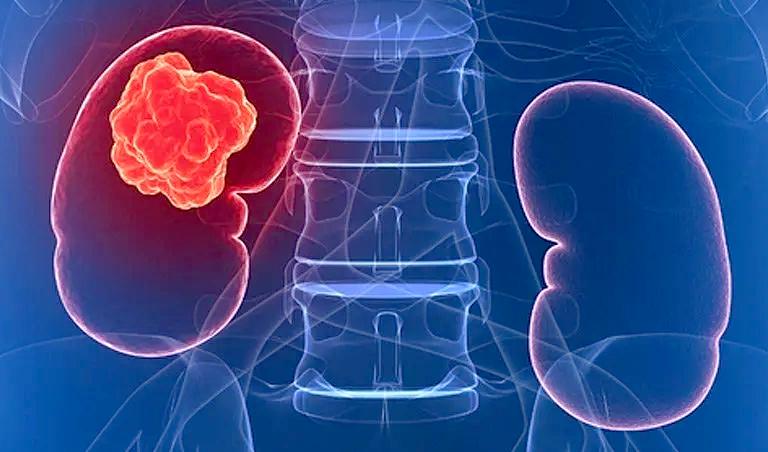Kidney Cancer
Treatment options for kidney cancer often include surgical interventions, with radical nephrectomy, partial nephrectomy, and laparoscopic nephrectomy being the primary surgical approaches. Here’s an in-depth look at each of these procedures:
Radical Nephrectomy
Description:
Radical nephrectomy involves the complete removal of the affected kidney along with surrounding tissues, which may include the adrenal gland, nearby lymph nodes, and surrounding fatty tissue.
Procedure:
- Preparation: The patient receives general anesthesia.
- Incision: An incision is made in the abdomen or side (flank).
- Removal: The surgeon removes the kidney along with the tumor, and possibly the adrenal gland and nearby lymph nodes if necessary.
- Closure: The incision is closed with sutures or staples.
Advantages:
- Comprehensive Treatment: Effective for larger or more advanced tumors.
- Reduced Risk of Recurrence: Removes the entire kidney and surrounding tissues that might contain cancer cells.
Disadvantages:
- Invasiveness: Major surgery with a longer recovery time.
- Loss of Kidney Function: The patient will rely on the remaining kidney, which may impact overall kidney function.
- Potential Complications: Risk of bleeding, infection, and other surgical complications.
Partial Nephrectomy
Description:
Partial nephrectomy, also known as nephron-sparing surgery, involves removing only the tumor and a small margin of healthy tissue, preserving the rest of the kidney.
Procedure:
- Preparation: The patient receives general anesthesia.
- Incision: An incision is made in the abdomen, side (flank), or back.
- Removal: The tumor and a small margin of healthy tissue are excised while preserving as much of the kidney as possible.
- Closure: The incision is closed with sutures or staples.
Advantages:
- Kidney Preservation: Maintains kidney function by preserving part of the kidney.
- Effective for Small Tumors: Suitable for small, localized tumors.
- Reduced Long-term Risks: Lower risk of chronic kidney disease compared to radical nephrectomy.
Disadvantages:
- Technical Complexity: More challenging surgery requiring skilled surgeons.
- Potential for Recurrence: Higher risk if cancer cells are left behind.
- Surgical Risks: Risk of bleeding, infection, and other surgical complications.
Laparoscopic Nephrectomy
Description:
Laparoscopic nephrectomy is a minimally invasive procedure that can be used for both radical and partial nephrectomies. It involves the use of a laparoscope (a thin, flexible tube with a camera) and specialized instruments inserted through small incisions.
Procedure:
- Preparation: The patient receives general anesthesia.
- Incisions: Several small incisions are made in the abdomen.
- Laparoscope Insertion: The laparoscope and surgical instruments are inserted through these incisions.
- Removal:
- For Radical Nephrectomy: The entire kidney and surrounding tissues are removed through one of the incisions.
- For Partial Nephrectomy: Only the tumor and a small margin of healthy tissue are removed.
- Closure: The incisions are closed with sutures or surgical glue.
Advantages:
- Minimally Invasive: Smaller incisions result in less pain and quicker recovery.
- Reduced Hospital Stay: Often performed on an outpatient basis or with a short hospital stay.
- Less Blood Loss: Compared to open surgery.
Disadvantages:
- Technical Complexity: Requires advanced surgical skills and specialized equipment.
- Longer Operative Time: Can take longer than traditional open surgery.
- Potential Complications: Risk of injury to surrounding organs and other surgical complications.
Comparison and Decision-Making
- Tumor Size and Location: Small, localized tumors may be suitable for partial nephrectomy, while larger or more advanced tumors may require radical nephrectomy.
- Patient Health and Kidney Function: Preserving kidney function is crucial, especially in patients with pre-existing kidney conditions or those with only one kidney.
- Surgeon Expertise: The availability of skilled surgeons and advanced surgical facilities may influence the choice of procedure.
- Recovery and Quality of Life: Minimally invasive procedures like laparoscopic nephrectomy offer quicker recovery and less postoperative pain.
Summary
Radical nephrectomy, partial nephrectomy, and laparoscopic nephrectomy are the primary surgical options for treating kidney cancer. The choice of procedure depends on various factors, including the stage and location of the tumor, the patient's overall health, and the goal of preserving kidney function. Consulting with a urologist and a multidisciplinary team will help determine the most appropriate treatment plan tailored to the patient’s specific circumstances.

